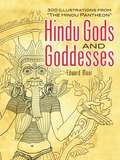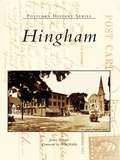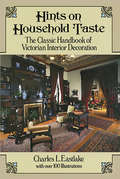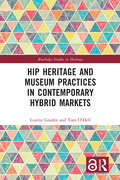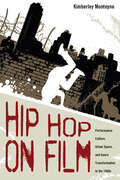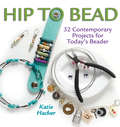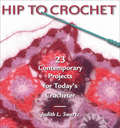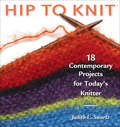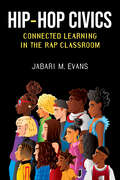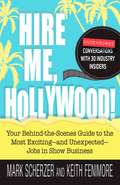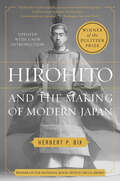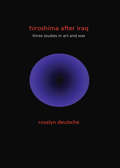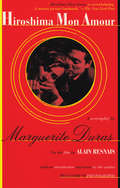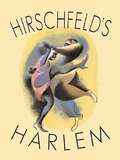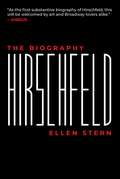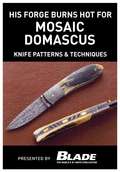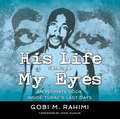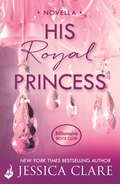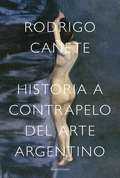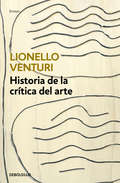- Table View
- List View
Hindu Gods and Goddesses: 300 Illustrations from "The Hindu Pantheon"
by Edward MoorReflecting the spirit of East Indian myths, legends, and fables, these illustrations were compiled by one of the nineteenth century's foremost Orientalists. Edward Moor published The Hindu Pantheon in 1810, and this new volume draws upon his exposition of India's religious iconography to offer a spectacular array of images of Hindu deities.Dramatic engravings and line drawings include scenes from the Ramayana and Mahabharata as well as temple images of Krishna, Vishnu, Siva, and other major gods and goddesses. Many are derived from bronze figurines; others are reproduced from manuscript illustrations. All appear with captions for ease of identification.
Hingham (Postcard History)
by Scott Wahle James PierottiThe established neighborhoods of Hingham make up a seashore community that has retained much of its historic charm. The Old Derby Academy, Old Ordinary Tavern, and the Old Ship Meetinghouse church are all local treasures. Atrip down Main Street affords extraordinary views of fine Victorian homes and Colonial farmhouses. Hingham was also home to the U.S. armed forces buildup during World Wars I and II. This Colonial settlement truly remains a celebrated all-American town.
Hints on Household Taste: The Classic Handbook of Victorian Interior Decoration
by Charles L. EastlakePrimary authority on what was proper, beautiful, efficient in all aspects of mid-19th-century interior design. Originally published in 1868. Over 100 illustrations.
Hip Heritage and Museum Practices in Contemporary Hybrid Markets
by Tom O'Dell Lizette GradénFocusing on how museums prioritize and produce content, Hip Heritage demonstrates how economic issues play an ever-larger role in determining how cultural heritage is being framed and presented in contemporary heritage museums. Drawing on ethnographic fieldwork conducted by the authors at seven museums over the course of five years, this book offers an in-depth analysis of heritage museums in Nordic, Scandinavian and North American contexts. It investigates how economic realities, coupled with the cultural contexts in which museums operate, affect how these institutions organize, manage and develop their collections to make themselves relevant in society. Once charged with the primary task of educating citizens about their cultural identity and history, national museums and heritage organizations are also under pressure to rethink their market demands and meet stakeholders’ increasing interest in growing visitor numbers and expanding economic returns. Simultaneously, many museums are part of a cultural sector with diminished public funding and increased competition for the existing financing. Against this background, this book questions: ‘When the budget is tight, whose heritage counts most?’ It considers museums as arenas for heritage politics in action on the local, national and international levels, as well as at the institutional level. Hip Heritage will appeal to scholars and students engaged in the study of ethnology heritage, museum studies, marketing, leisure and tourism, public folklore, and sociology.
Hip Heritage and Museum Practices in Contemporary Hybrid Markets (Routledge Studies in Heritage)
by Lizette Gradén Tom O'DellFocusing on how museums prioritize and produce content, Hip Heritage demonstrates how economic issues play an ever-larger role in determining how cultural heritage is being framed and presented in contemporary heritage museums.Drawing on ethnographic fieldwork conducted by the authors at seven museums over the course of five years, this book offers an in-depth analysis of heritage museums in Nordic, Scandinavian and North American contexts. It investigates how economic realities, coupled with the cultural contexts in which museums operate, affect how these institutions organize, manage and develop their collections to make themselves relevant in society. Once charged with the primary task of educating citizens about their cultural identity and history, national museums and heritage organizations are also under pressure to rethink their market demands and meet stakeholders’ increasing interest in growing visitor numbers and expanding economic returns. Simultaneously, many museums are part of a cultural sector with diminished public funding and increased competition for the existing financing. Against this background, this book questions: ‘When the budget is tight, whose heritage counts most?’ It considers museums as arenas for heritage politics in action on the local, national and international levels, as well as at the institutional level.Hip Heritage will appeal to scholars and students engaged in the study of ethnology heritage, museum studies, marketing, leisure and tourism, public folklore, and sociology.
Hip Hop on Film: Performance Culture, Urban Space, and Genre Transformation in the 1980s
by Kimberley MonteyneEarly hip hop film musicals have either been expunged from cinema history or excoriated in brief passages by critics and other writers. Hip Hop on Film reclaims and reexamines productions such as Breakin' (1984), Beat Street (1984), and Krush Groove (1985) in order to illuminate Hollywood's fascinating efforts to incorporate this nascent urban culture into conventional narrative forms. Such films presented musical conventions against the backdrop of graffiti-splattered trains and abandoned tenements in urban communities of color, setting the stage for radical social and political transformations. Hip hop musicals are also part of the broader history of teen cinema, and films such as Charlie Ahearn's Wild Style (1983) are here examined alongside other contemporary youth-oriented productions. As suburban teen films banished parents and children to the margins of narrative action, hip hop musicals, by contrast, presented inclusive and unconventional filial groupings that included all members of the neighborhood. These alternative social configurations directly referenced specific urban social problems, which affected the stability of inner-city families following diminished governmental assistance in communities of color during the 1980s. Breakdancing, a central element of hip hop musicals, is also reconsidered. It gained widespread acclaim at the same time that these films entered the theaters, but the nation's newly discovered dance form was embattled—caught between a multitude of institutional entities such as the ballet academy, advertising culture, and dance publications that vied to control its meaning, particularly in relation to delineations of gender. As street-trained breakers were enticed to join the world of professional ballet, this newly forged relationship was recast by dance promoters as a way to invigorate and “remasculinize” European dance, while young women simultaneously critiqued conventional masculinities through an appropriation of breakdance. These multiple and volatile histories influenced the first wave of hip hop films, and even structured the sleeper hit Flashdance (1983). This forgotten, ignored, and maligned cinema is not only an important aspect of hip hop history, but is also central to the histories of teen film, the postclassical musical, and even institutional dance. Kimberley Monteyne places these films within the wider context of their cultural antecedents and reconsiders the genre's influence.
Hip to Bead: 32 Contemporary Projects For Today's Beader (Hip To ... Ser.)
by Katie HackerContemporary, boutique-style beaded jewelry and accessories are a breeze to make with the step-by-step instructions and inspirational photographs in this guide. Thirty-two stylish projects - including the Rock 'n Roll Cuff, the Cha Cha Bracelet, and the Mod Millefiori Necklace - can be created using the basic beading techniques described, including knotting, stringing, weaving, and working with wire. Sidebars provide more extensive coverage of materials, types of beads, essential tools, and modified designs for advanced beaders and a list of suppliers makes it easy to find everything needed to create the designs.
Hip to Crochet: 23 Contemporary Projects For Today's Crocheter
by Judith L. SwartzA broad range of garment patterns and home accessory projects that transform traditional crochet projects into today's trendiest clothing are provided in this collection of fashionable crochet designs. Presented with easy, step-by-step instructions, illustrations, and photos, these 23 projects include a bohemian coat sweater, a mohair hat, retro bed slippers, and an assortment of trendsetting bags. Projects are included for baskets, pillows, and a throw to add a stylish twist to a crocheter's home decor. In addition to introducing basic crochet techniques, this guide tackles more advanced projects using a variety of yarns, including mohair, merino, angora blends, and linen.
Hip to Knit: 18 Contemporary Projects For Today's Knitter (Hip To ... Ser.)
by Judith L. SwartzKnitting is no longer just a grandmother's pastime! This extraordinary guide for the newer or younger knitter introduces classic and contemporary patterns that can be completed in a reasonable time, with clear, precise instructions. The creative, hip, and diverse designs include a boyfriend's sweater, chunky scarf, halter top, color block tote bag, cute mittens, mismatched striped socks, and much more. Each project is rounded out with a mini-lesson that covers such practical skills as fringing and striping, circular knitting, working with double pointed needles, and creating decorative edges and decreases. This collection is the beginner's single source for getting started and having fun with chic designs that will never go out of style.
Hip to Stitch
by Melinda BartaIdeas for embellishing beautiful garments and home decor to add personal touches are presented with easy, step-by-step instructions, illustrations, and 38 stitch techniques and 20 hand-embroidered projects, in this stylish stitching how-to. Included are motifs to dress up a skirt, day tripper bags, a guitar pick case, a picnic baby bib, a butterfly picture frame, hand-embroidered pillows, stitched note cards, and heirloom scrapbooks. Throughout the book are helpful tips and hints such as hiding knots and thread tails, sewing a pocket, making durable stitches, and working with silk and wire. In addition to teaching the basics, this guide can make projects ambitious by experimenting with stitches and the number and placement of motifs so that even experienced stitchers will find renewed inspiration for embroidery.
Hip-Hop Civics: Connected Learning in the Rap Classroom (Music and Social Justice)
by Jabari M. EvansIn Hip-Hop Civics, Jabari Evans demonstrates how Hip-Hop can be deployed in revamping formal civic education for Black and Brown youth. Based on an original ethnographic study of a Hip-Hop-based education program, the Songwriting and Production Program (SWP) administered by the Foundation of Music in two of Chicago’s lowest performing public schools, Evans argues that Hip-Hop culture is central to students’ lives and can be used as a vehicle for students to engage in civic practices and extract critical lessons about mainstream media, relational currency, identity development, and race/racism within the classroom. Through a compelling exploration of the SWP program, Evans contends that Hip-Hop should be part of formal education spaces and instruction, a conclusion he reaches through his understanding of how Hip-Hop impacted his own life, and by witnessing students discuss, write, and produce Hip-Hop music as part of the SWP program.
Hire Me Hollywood
by Mark Scherzer Keith FenimoreThe secret to Stan Lee's writing process The story behind Elmo's giggle What's for lunch on the set of The Walking Dead Squirrel training with Johnny Depp Think you know what it takes to get your favorite TV show on the air every week? (You'd be surprised. ) Or what all those people whose names in the credits of the latest blockbuster actually do? (Including the Supervising Digital Colorist?) What better way to find out than from the who's who of Hire Me, Hollywood! Entertainment insiders Mark Scherzer and Keith Fenimore are here to give you a crash course in all things Hollywood through thirty sometimes funny, occasionally racy, and always revealing interviews with such industry experts as: Ryan Randall, Hair Stylist/Makeup Artist ( American Idol ) Sam Trammell, Actor (Sam Merlotte on HBO's True Blood ) Paula Davis, Senior Talent Executive (Conan O'Brien) Mark Steines, Cohost ( Entertainment Tonight ) Sara Holden, Stunt Woman ( House, All My Children, How I Met Your Mother, Iron Man 2 ) Cecilia Cardwell, On-Set Tutor ( Titanic, Little Miss Sunshine, No Ordinary Family ) Michael Gelman, Executive Producer ( Live! with Regis and Kelly ) Whether you've always dreamed of yelling Action on a major movie set or you'd be thrilled just to get George Clooney his morning coffee, this book will give you inside scoop from craft service to the director's chair--and every take in between.
Hire Me, Hollywood!
by Mark Scherzer Keith FenimoreThe secret to Stan Lee's writing processThe story behind Elmo's giggleWhat's for lunch on the set of The Walking DeadSquirrel training with Johnny DeppThink you know what it takes to get your favorite TV show on the air every week? (You'd be surprised.) Or what all those people whose names in the credits of the latest blockbuster actually do? (Including the Supervising Digital Colorist?)What better way to find out than from the who's who of Hire Me, Hollywood!Entertainment insiders Mark Scherzer and Keith Fenimore are here to give you a crash course in all things Hollywood through thirty sometimes funny, occasionally racy, and always revealing interviews with such industry experts as:Ryan Randall, Hair Stylist/Makeup Artist (American Idol)Sam Trammell, Actor (Sam Merlotte on HBO's True Blood)Paula Davis, Senior Talent Executive (Conan O'Brien)Mark Steines, Cohost (Entertainment Tonight)Sara Holden, Stunt Woman (House, All My Children, How I Met Your Mother, Iron Man 2)Cecilia Cardwell, On-Set Tutor (Titanic, Little Miss Sunshine, No Ordinary Family)Michael Gelman, Executive Producer (Live! with Regis and Kelly)Whether you've always dreamed of yelling "Action" on a major movie set or you'd be thrilled just to get Matthew McConaughey his morning coffee, this book will give you inside scoop from craft service to the director's chair--and every take in between.
Hire Me, Hollywood!: Your Behind-the-Scenes Guide to the Most Exciting - and Unexpected - Jobs in Show Business
by Mark ScherzerThe secret to Stan Lee's writing processThe story behind Elmo's giggleWhat's for lunch on the set of The Walking DeadSquirrel training with Johnny DeppThink you know what it takes to get your favorite TV show on the air every week? (You'd be surprised.) Or what all those people whose names in the credits of the latest blockbuster actually do? (Including the Supervising Digital Colorist?)What better way to find out than from the who's who of Hire Me, Hollywood!Entertainment insiders Mark Scherzer and Keith Fenimore are here to give you a crash course in all things Hollywood through thirty sometimes funny, occasionally racy, and always revealing interviews with such industry experts as:Ryan Randall, Hair Stylist/Makeup Artist (American Idol)Sam Trammell, Actor (Sam Merlotte on HBO's True Blood)Paula Davis, Senior Talent Executive (Conan O'Brien)Mark Steines, Cohost (Entertainment Tonight)Sara Holden, Stunt Woman (House, All My Children, How I Met Your Mother, Iron Man 2)Cecilia Cardwell, On-Set Tutor (Titanic, Little Miss Sunshine, No Ordinary Family)Michael Gelman, Executive Producer (Live! with Regis and Kelly) Whether you've always dreamed of yelling "Action" on a major movie set or you'd be thrilled just to get Matthew McConaughey his morning coffee, this book will give you inside scoop from craft service to the director's chair-and every take in between.
Hirohito And The Making Of Modern Japan
by Herbert P BixWinner of the Pulitzer PrizeIn this groundbreaking biography of the Japanese emperor Hirohito, Herbert P. Bix offers the first complete, unvarnished look at the enigmatic leader whose sixty-three-year reign ushered Japan into the modern world. Never before has the full life of this controversial figure been revealed with such clarity and vividness. Bix shows what it was like to be trained from birth for a lone position at the apex of the nation's political hierarchy and as a revered symbol of divine status. Influenced by an unusual combination of the Japanese imperial tradition and a modern scientific worldview, the young emperor gradually evolves into his preeminent role, aligning himself with the growing ultranationalist movement, perpetuating a cult of religious emperor worship, resisting attempts to curb his power, and all the while burnishing his image as a reluctant, passive monarch. Here we see Hirohito as he truly was: a man of strong will and real authority.Supported by a vast array of previously untapped primary documents, Hirohito and the Making of Modern Japan is perhaps most illuminating in lifting the veil on the mythology surrounding the emperor's impact on the world stage. Focusing closely on Hirohito's interactions with his advisers and successive Japanese governments, Bix sheds new light on the causes of the China War in 1937 and the start of the Asia-Pacific War in 1941. And while conventional wisdom has had it that the nation's increasing foreign aggression was driven and maintained not by the emperor but by an elite group of Japanese militarists, the reality, as witnessed here, is quite different. Bix documents in detail the strong, decisive role Hirohito played in wartime operations, from the takeover of Manchuria in 1931 through the attack on Pearl Harbor and ultimately the fateful decision in 1945 to accede to an unconditional surrender. In fact, the emperor stubbornly prolonged the war effort and then used the horrifying bombings of Hiroshima and Nagasaki, together with the Soviet entrance into the war, as his exit strategy from a no-win situation. From the moment of capitulation, we see how American and Japanese leaders moved to justify the retention of Hirohito as emperor by whitewashing his wartime role and reshaping the historical consciousness of the Japanese people. The key to this strategy was Hirohito's alliance with General MacArthur, who helped him maintain his stature and shed his militaristic image, while MacArthur used the emperor as a figurehead to assist him in converting Japan into a peaceful nation. Their partnership ensured that the emperor's image would loom large over the postwar years and later decades, as Japan began to make its way in the modern age and struggled -- as it still does -- to come to terms with its past.Until the very end of a career that embodied the conflicting aims of Japan's development as a nation, Hirohito remained preoccupied with politics and with his place in history. Hirohito and the Making of Modern Japan provides the definitive account of his rich life and legacy. Meticulously researched and utterly engaging, this book is proof that the history of twentieth-century Japan cannot be understood apart from the life of its most remarkable and enduring leader.
Hiroshima After Iraq: Three Studies in Art and War
by Rosalyn DeutscheMany on the left lament an apathy or amnesia toward recent acts of war. Particularly during the George W. Bush administration's invasion of Iraq, opposition to war seemed to lack the heat and potency of the 1960s and 1970s, giving the impression that passionate dissent was all but dead. Through an analysis of three politically engaged works of art, Rosalyn Deutsche argues against this melancholic attitude, confirming the power of contemporary art to criticize subjectivity as well as war. Deutsche selects three videos centered on the deployment of the atomic bomb: Krzysztof Wodiczko's Hiroshima Projection (1999), made after the first Gulf War; Silvia Kolbowski's After Hiroshima mon amour (2005-2008); and Leslie Thornton's Let Me Count the Ways (2004-2008), which followed the U.S. invasion of Iraq. Each of these works confronts the ethical task of addressing historical disaster, and each explores the intersection of past and present wars. These artworks profoundly contribute to the discourse of war resistance, illuminating the complex dynamics of viewing and interpretation. Deutsche employs feminist and psychoanalytic approaches in her study, questioning both the role of totalizing images in the production of warlike subjects and the fantasies that perpetuate, especially among the left, traditional notions of political dissent. She ultimately reveals the passive collusion between leftist critique and dominant discourse in which personal dimensions of war are denied.
Hiroshima After Iraq: Three Studies in Art and War (The Wellek Library Lectures)
by Rosalyn DeutscheMany on the left lament an apathy or amnesia toward recent acts of war. Particularly during the George W. Bush administration's invasion of Iraq, opposition to war seemed to lack the heat and potency of the 1960s and 1970s, giving the impression that passionate dissent was all but dead. Through an analysis of three politically engaged works of art, Rosalyn Deutsche argues against this melancholic attitude, confirming the power of contemporary art to criticize subjectivity as well as war. Deutsche selects three videos centered on the deployment of the atomic bomb: Krzysztof Wodiczko's Hiroshima Projection (1999), made after the first Gulf War; Silvia Kolbowski's After Hiroshima mon amour (2005-2008); and Leslie Thornton's Let Me Count the Ways (2004-2008), which followed the U.S. invasion of Iraq. Each of these works confronts the ethical task of addressing historical disaster, and each explores the intersection of past and present wars. These artworks profoundly contribute to the discourse of war resistance, illuminating the complex dynamics of viewing and interpretation. Deutsche employs feminist and psychoanalytic approaches in her study, questioning both the role of totalizing images in the production of warlike subjects and the fantasies that perpetuate, especially among the left, traditional notions of political dissent. She ultimately reveals the passive collusion between leftist critique and dominant discourse in which personal dimensions of war are denied.
Hiroshima Mon Amour: A Screenplay (Facile A Lire Ser. #No. 9)
by Marguerite DurasOne of the most influential works in the history of cinema, Alain Renais's Hiroshima Mon Amour gathered international acclaim upon its release in 1959 and was awarded the International Critics' Prize at the Cannes Film festival and the New York Film Critics' Award. Ostensibly the story of a love affair between a Japanese architect and a French actress visiting Japan to make a film on peace, Hiroshima Mon Amour is a stunning exploration of the influence of war on both Japanese and French culture and the conflict between love and inhumanity.
Hirschfeld's Harlem
by Al HirschfeldDecades before the PBS documentaries, before Bill Clinton, Al Hirschfeld went to Harlem and captured Harlem's dangerous highs and bluesy lows. Hirschfeld's Harlem opens a picture window into nearly a century of Black American artistry and life. Each drawing is accompanied by a thumbnail narrative by Hirschfeld about the most famous inhabitants and transients of the fabled streets.
Hirschfeld: The Biography
by Ellen SternThe definitive biography of Al Hirschfeld, renowned caricaturist and artist. Al Hirschfeld knew everybody and drew everybody. He occupied the twentieth century, and illustrated it. Hirschfeld: The Biography is the first portrait of the renowned artist's life—as spirited and unique as his pen-and-ink drawings. Beginning in the 1920s, he caricatured Hollywood actors, Washington politicians, and—his favorite—celebrities of the stage. Broadway belonged to Hirschfeld. His work appeared in the New York Times and other publications, as well as on book jackets, album covers, posters, and postage stamps, for more than seventy-five years. He lived in Paris, Moscow, and Bali, and in a pink New York townhouse on a star-studded block where his closest friends—Carol Channing, S. J. Perelman, Gloria Vanderbilt, Brooks Atkinson, Elia Kazan, Marlene Dietrich, and William Saroyan—flocked in and out. He played the piano, went to jazz joints with Eugene O'Neill, and wrote a musical that bombed. He drove until he was ninety-eight years old and always found a parking space. He worked every day, threw dinner parties twice a week, and hosted New Year's Eve soirees that were legendary. He had three wives, a formidable agent, and a daughter, Nina, the most famous little girl that no one knows. Hirschfeld died in 2003, at the age of ninety-nine. "If you live long enough," he liked to say, "everything happens." For him, it did. And good and bad—it's all here. Through interviews with Hirschfeld himself, his friends and family (including the mysterious Nina), and his famous subjects, as well as through letters, scrapbooks, and home movies, Ellen Stern has crafted a delightful, detailed, and definitive portrait of Al Hirschfeld, one of our most beloved, and most influential, artists.
His Forge Burns Hot for Mosaic Damascus: Knife Patterns & Techniques
by Joe KertzmanAmerican Bladesmith Society master smith Rick Dunkerley lights the mosaic-damascus fire, recommending steels and explaining the forge welding process, as well as steel stacking, pattern making, finishing and much more. Dunkerley includes diagrams and how-to sidebars on mosaic damascus patterns.
His Life Through My Eyes
by Gobi M. RahimiGobi M. Rahimi spent Tupac Shakur's last eight months with him, serving as a co-producer and director for many of his music videos and short films. Along the way, he took behind-the-scenes photographs of Tupac in more relaxed, casual settings. Gobi's photos and words show a side of Tupac that is rarely seen, and humanizes a man who has since become a legend.
His Royal Princess: A Billionaire Boys Club Novella (Billionaire Boys Club)
by Jessica ClareFans of J.S. Scott, Louise Bay and Melody Anne - prepare to be dazzled by Jessica Clare's Billionaire Boys Club.The Billionaire Boys Club is a secret society of six incredibly wealthy men who have vowed success in business - at any cost. But success when it comes to love is a different matter...Their romance led to a royal wedding in Once Upon a Billionaire. Now see how it all began for Princess Alexandra of Bellissime and American actor Luke Houston.As heir to the throne of Bellissime, Princess Alexandra is supposed to be cool and calm...not crushing on a movie star. When she hears that Luke Houston is filming a scene for his next movie in her tiny country, however, she can't resist sneaking onto set to get a glimpse of the Hollywood hunk. When Alex is almost caught on set by the press, she ducks into the first available hiding place - only to find herself in Luke's private trailer, and getting much more than just a glimpse of him. It's an up close and personal encounter that sets her heart aflutter, and sets her mind on some very unladylike plans to get to know him better...Want more irresistible romance? Look for the rest of the Billionaire Boys Club titles, starting with Stranded With A Billionaire, as well as the sizzling spinoff series, Billionaires and Bridesmaids, starting with The Billionaire And The Virgin.
Historia a contrapelo del arte argentino
by Rodrigo CañeteContranarrativa del arte argentino que lee su historia desde la perspectiva de los traumas nacionales que encontraron expresión en su producción estética, en particular, visual. Reflexivo, crítico y polémico, Cañete desempolva el museo de la patria y sacude su panteón. Este libro presenta una historia del arte argentino construida a partir de una mirada ética y estéticamente crítica. Su punto de partida es la pregunta sobre la existencia misma de su objeto; su propósito, promover y vigorizar un debate necesariamente reflexivo, argumentado y, por definición, político. En ese gesto, Rodrigo Cañete se propone, además de poner en discusión el canon artístico nacional, sacar a los artistas de los panteones históricos y contemporáneos en los que instituciones y élites los han ido confinando, y desempolvar el museo de la patria para enfrentar los fantasmas que en última instancia acechan a la Argentina como país signado por la exclusión, el racismo y la veneración por lo extranjero. Largamente esperada, intelectualmente desafiante e inevitablemente polémica, Historia a contrapelo del arte argentino es también un repertorio de recursos para que sus lectores se abran paso en esos "circuitos" de la producción estética que con frecuencia se presentan como públicos al tiempo que se comportan refractarios, laberínticos y endogámicamente blindados.
Historia de la crítica del arte
by Lionello VenturiEl ensayo más célebre de uno de los intelectuales y pensadores más decisivos de la historia del arte contemporánea. Las páginas del presente libro abarcan un vastísimo período que va de la era clásica a la contemporánea. Sin limitarse únicamente a señalar y comentar textos pertenecientes explícitamente a la denominada literatura artística, esta rica y amplia investigación ofrece una pormenorizada historia de las ideas, de las teorías, de las apreciaciones, de la toma de posición que atañe al arte figurativo desde hace siglos. La actitud de los críticos, de los pensadores, de los artistas es analizada con la intención de destacar el curso cambiante de las reflexiones sobre el arte y hacer emerger sus momentos cruciales, restituyendo así la condición misma del arte a lo largo de la historia. Reseña:«El gran Lionello Venturi, en Historia de la crítica del arte, lamentaba la dicotomía planteada, en el mundo moderno, entre historia y crítica de arte. Tal conflicto, años después de su advertencia, continúa vigente.»Francisco Calvo Serraller, El País
